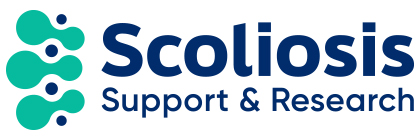Monday – Friday 9am to 5pm
Allie Sumner’s story, by mum Ivana Sumner
My 3-year-old daughter Allie has infantile early onset thoracolumbar scoliosis. Allie was a happy, healthy baby when she was born but had a very prominent birth mark on the base of her spine. When she was about 4 months old my sister felt a lump on the baby’s side, like her back was sticking out further on one side. I could feel it too, but Allie was hitting her milestones early and it didn’t seem to bother her. When Allie started crawling I noticed that one side would always give way, always the same side, the side opposite her lump. I wondered if this was related to the lump but never having heard of scoliosis, it didn’t seem like an issue that needed to be brought up because other than that, Allie was doing great.
Allie was about 14 months old when she started walking and I noticed her gait was off, she was standing curved, and her balance was off. Allie was at one point seen by an orthopaedic specialist who said that the birth mark itself was a sign of a spine deformity. Allie was taken in for an X-ray and afterwards I thought she was looking at an example of a spine with scoliosis, but was shocked to find out it was my daughter’s spine and that it was larger than I ever would have guessed by looking at her.
This specialist referred Allie to their nearest scoliosis centre in Edinburgh which was still 120 miles away for us. Allie was then diagnosed with a 65-degree curve at 18 months old. An MRI and CT scan was ordered to see if there was an underlying cause, but it was confirmed that Allie’s scoliosis was idiopathic. This was hard for me to accept – that my daughter’s spine could be this curved without knowing why. Allie was also booked into a moulding for a cast so that could be fitted as soon as possible to try to contain the curve. Her spine is rotating, as well as curving and the specialist had to explain to me that this could put Allie’s lungs and heart in danger of being squashed so they had to act fast. Every step up until the point of seeing the scoliosis specialist had seemed so slow so this was a shock and quite upsetting.
In November of 2021 we went back to the specialist, and the curve had reduced to 50 degrees from 65 degrees. Ivana was ecstatic but the specialist wasn’t. Allie had grown so much in the 6 months that he was worried that she was growing too fast, and they had to get her in a brace as soon as possible. In subsequent visits, Allie’s curve has continued to grow after that initial 15-degree correction. At first it went up to 52 degrees but the last time they checked it was up to 56 degrees. The treatment plans can change every time they see the surgeon because they’re reacting to how Allie is responding to the latest brace. In the last appointment the surgeon explained that the brace is delaying surgery, but that Allie would have to have growing rods to further control the curve while she grows, and that this would need to happen sooner than they had aimed for. I worry going into each appointment but reminds myself that it can be treated, and it will be treated, but it’s a long process finding the right way to treat idiopathic scoliosis.
Allie calls her brace ‘knock-knock’ for the sound it makes when you knock on it, but she has no idea why she has to wear it, she doesn’t understand that there’s something wrong with her back. Each brace is traumatic for Allie, it fits differently from the previous one, it hurts her, and she has to get used to it again. The specialist is compassionate, and Allie loves him, but he has had to be very honest and to the point with us. I don’t want to be kept in the dark and want the facts so that it pushes me to keep up with bracing and make sure Allie is wearing it for 20 hours a day, as prescribed. We have built a good routine with the brace and this has been so important. Allie knows she can have her knock-knock off just before dinnertime and for bath-time, so when she smells her dinner, she will come up to me and say ‘knock-knock off!’.
Allie is full of energy, just as rambunctious as any kid out there, jumping on trampolines and doing somersaults. There are going to be points in time where she won’t be able to do that but, in the meantime, I want her to enjoy it.
Putting on a brace can be difficult at first. You’re shown by the orthotist but as soon as you are home by yourself, you question everything. You get used to it and figure it out, listening to your child and taking notice of the way they move can help. There are a few struggles, and each new brace starts a new period of settling in and pulling on the top strap is never fun.
As a parent of a young child with scoliosis, even though it’s the child actually going through this, it’s the parents who understand what’s happening and have to agonise over every decision. This isn’t really any different from how any parent feels though, and you never know if you’re doing it right, you just do what you have to do to get it done.
If you would like to talk further about any aspect of scoliosis, SAUK is here to help; please call our helpline or contact us via post or using our e-mail address info@sauk.org.uk.
© 2024 Scoliosis Support & Research | Scoliosis Support & Research is a registered charity no. 1181463
Website design & development by Pedalo

